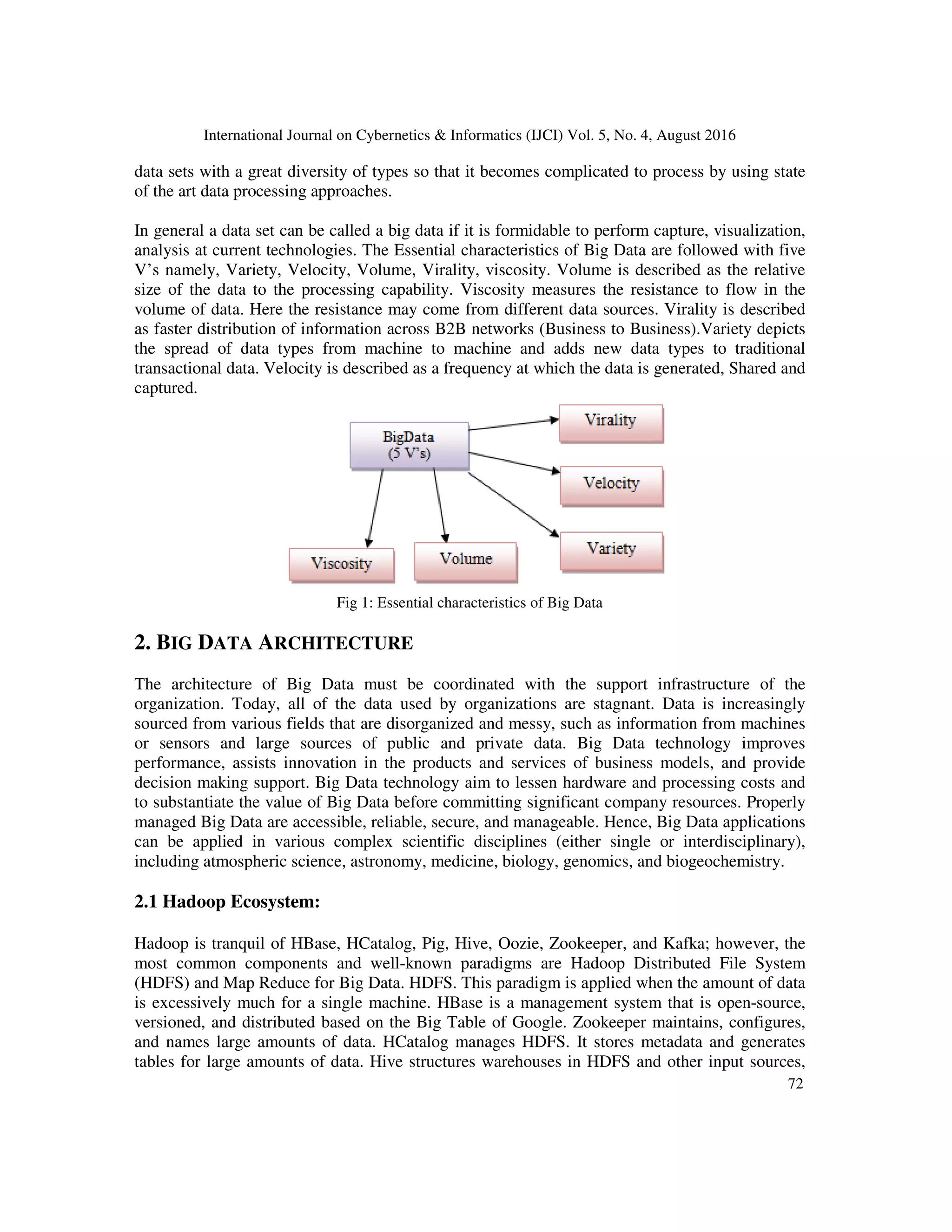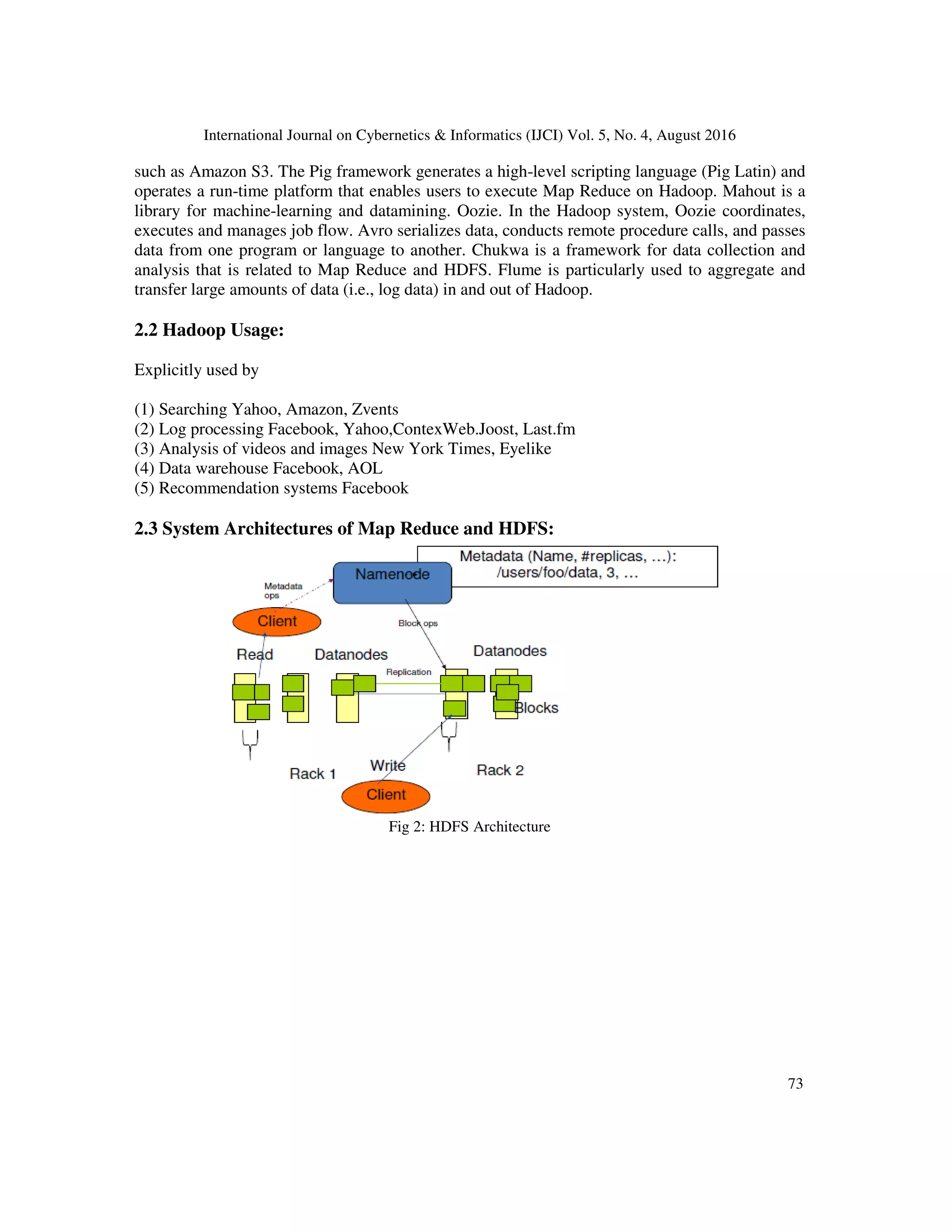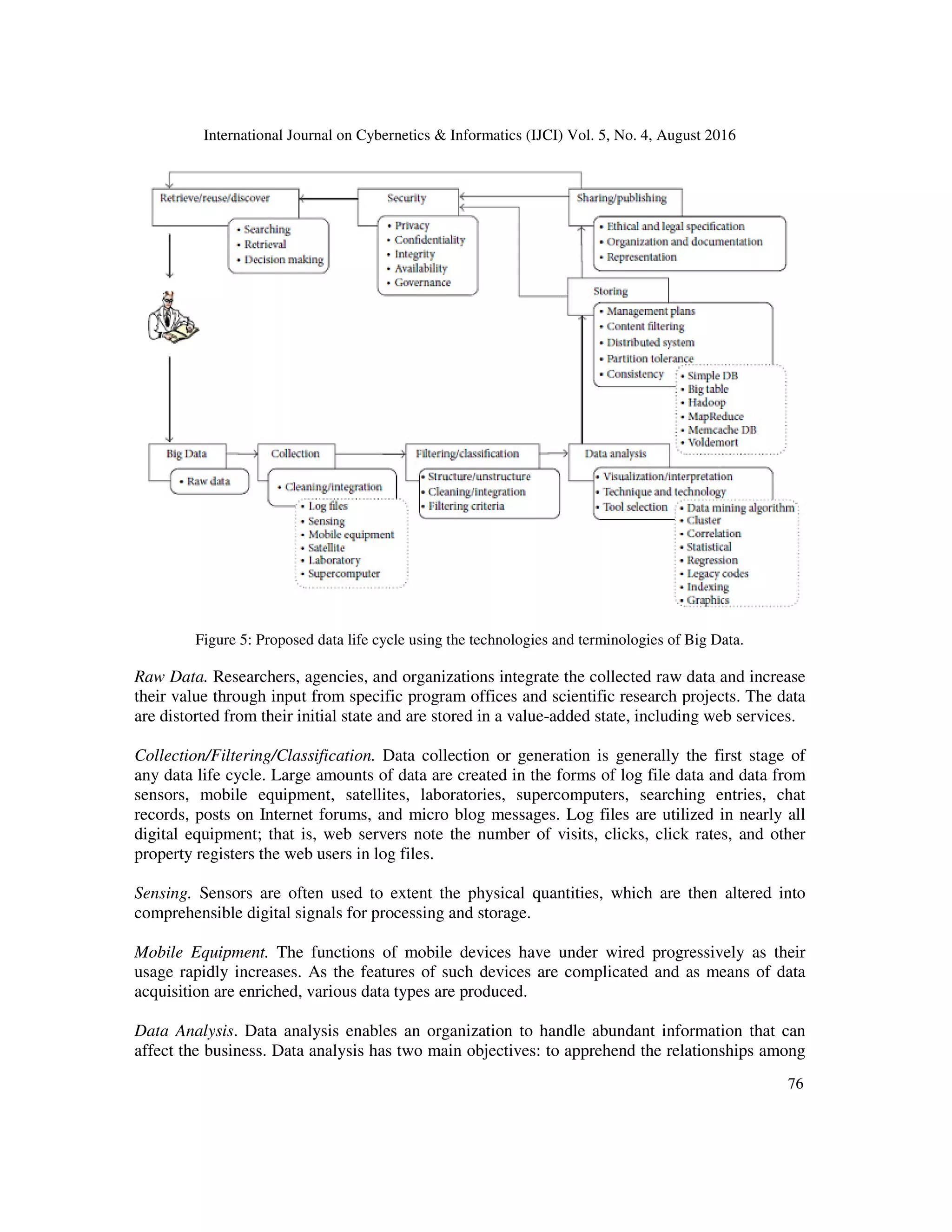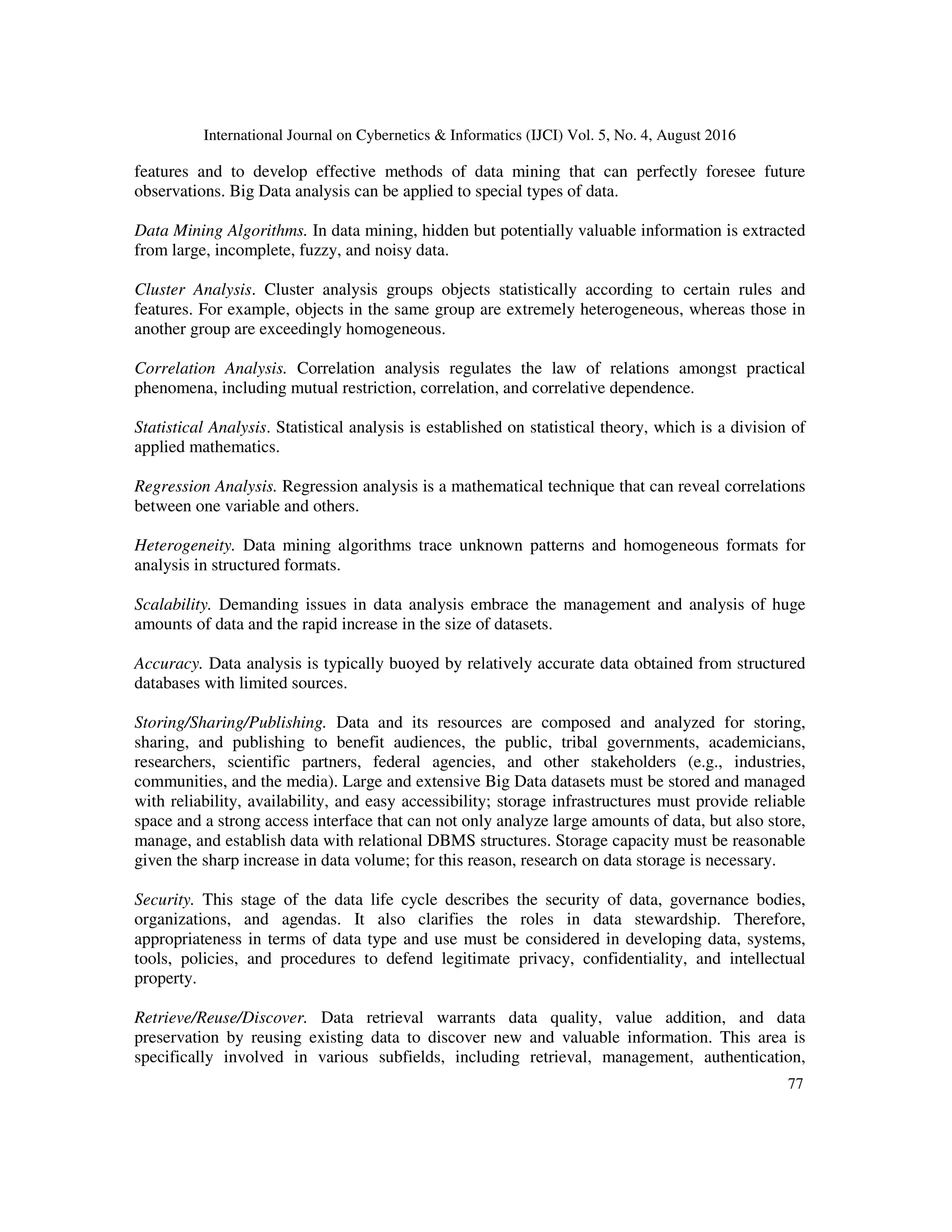This document provides a comprehensive study on big data applications and challenges, highlighting its rapid growth, complexity, and the technological frameworks such as Hadoop and MapReduce used for processing it. It discusses the essential characteristics of big data, including volume, variety, and velocity, as well as challenges like data inconsistency, privacy, and the need for improved data management techniques. The study concludes that further research is necessary to address these challenges and optimize big data's utility in various fields.







![International Journal on Cybernetics & Informatics (IJCI) Vol. 5, No. 4, August 2016
78
archiving, preservation, and representation. The classical approach to structured data
management is divided into two parts: one is a schema to store the dataset and the other is a
relational database for data retrieval.
3. CHALLENGES
With Big Data, users not only face abundant attractive prospects but also come across challenges.
Such complications lie in data capture, storage, searching, sharing, analysis, and visualization.
Challenges in Big Data analysis include data inconsistency and incompleteness, scalability,
timeliness, and security. Prior to data analysis, data must be well constructed. Understanding the
method by which data can be preprocessed is important to improve data quality and the analysis
results. Privacy is major concern in outsourced data. Recently, some arguments have discovered
how some security agencies are using data generated by individuals for their own benefits
without permission.
4. CONCLUSION
This paper presents the elementary concepts of Big Data. These concepts comprise the role of Big
Data in the current environment of enterprise and technology. To augment the efficiency of data
management, we have devised a data-lifecycle that uses the technologies and terminologies of
BigData. The stages in this life cycle include collection, filtering, analysis, storage, publication,
retrieval, and discovery. Data are also generated in different formats(unstructured and/or semi
structured), which unfavorably affect data analysis, management, and storage. This deviation in
data is accompanied by complexity and the development of further means of data acquisition. Big
Data has developed such that it cannot be harnessed separately. Big Data is characterized by large
systems, profits, and challenges. As a result, additional research is obligatory to address these
issues and advance the efficient display, analysis, and storage of Big Data. To improve such
research, capital investments, human resources, and pioneering ideas are the basic requirements.
REFERENCES
[1] C.L. Philip Chen, Chun-Yang Zhang, “Data-intensive applications, challenges, techniques and
technologies: A survey on Big Data”, Information Sciences, www.elsevier.com/locate/ins, January
2014.
[2] Xindong Wu, Xingquan Zhu, Gong-Qing Wu, Wei Ding, “Data Mining with Big Data”, IEEE
Transactions On Knowledge and Data Engineering, vol. 26, no. 1, January 2014,pp.97-107.
[3] “IBM What Is Big Data: Bring Big Data to the Enterprise,” http://www-
01.ibm.com/software/data/bigdata/, IBM, 2012.
[4] Xindong Wu, Xingquan Zhu, Gong-Qing Wu, Wei Ding, “Data Mining with Big Data”, IEEE
Transactions On Knowledge and Data Engineering, vol. 26, no. 1, January 2014,pp.97-107.
[5] unping Zhang, Fei-Yue Wang, Kunfeng Wang, Wei-Hua Lin, Xin Xu, Cheng Chen, Data-driven
intelligent transportation systems: a survey, IEEE Trans. Intell. Trans. Syst. 12 (4) (2011) 1624–1639.
[6] D. Che, M. Safran, and Z. Peng, “From big data to big data mining: challenges, issues, and
opportunities,” in Database Systems for Advanced Applications, B. Hong, X.Meng, L. Chen,W.
Winiwarter, and W. Song, Eds., vol. 7827 of Lecture Notes in Computer Science, pp. 1–15, Springer,
Berlin, Germany, 2013.](https://image.slidesharecdn.com/5416ijci09-160907063404/75/A-Comprehensive-Study-on-Big-Data-Applications-and-Challenges-8-2048.jpg)
![International Journal on Cybernetics & Informatics (IJCI) Vol. 5, No. 4, August 2016
79
[7] Z. Sebepou and K. Magoutis, “Scalable storage support for data stream processing,” in Proceedings
of the IEEE 26th Symposium on Mass Storage Systems and Technologies (MSST ’10), pp. 1–6,
Incline Village, Nev, USA, May 2010.
[8] A. Katal, M. Wazid, and R. H. Goudar, “Big data: issues, challenges, tools and good practices,” in
Proceedings of the 6th International Conference on Contemporary Computing (IC3 '13), pp. 404–409,
IEEE, 2013.
[ 9] A. Azzini and P. Ceravolo, “Consistent process mining over big data triple stores,” in Proceeding of
the International Congress on Big Data (BigData '13), pp. 54–61, 2013.
[10] A. O’Driscoll, J. Daugelaite, and R. D. Sleator, “’Big data’, Hadoop and cloud computing in
genomics,” Journal of Biomedical Informatics, vol. 46, no. 5, pp. 774–781, 2013.
[11] Y. Demchenko, P. Grosso, C. de Laat, and P. Membrey, “Addressing big data issues in scientific data
infrastructure,” in Proceedings of the IEEE International Conference on Collaboration Technologies
and Systems (CTS ’13), pp. 48–55, May 2013.
[12] Y. Demchenko, C. Ngo, and P. Membrey, “Architecture Framework and Components for the Big
Data Ecosystem,” Journal of System and Network Engineering, pp. 1–31, 2013.
[13] M. Loukides, “What is data science? The future belongs to the companies and people that turn data
into products,” AnOReilly Radar Report, 2010.
[14] A.Wahab,M. Helmy, H.Mohd, M. Norzali, H. F. Hanafi, and M. F. M. Mohsin, “Data pre-processing
on web server logs for generalized association rules mining algorithm,” Proceedings of World
Academy of Science: Engineering & Technology, pp. 48–53.](https://image.slidesharecdn.com/5416ijci09-160907063404/75/A-Comprehensive-Study-on-Big-Data-Applications-and-Challenges-9-2048.jpg)